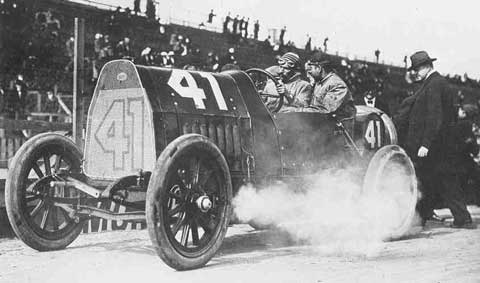
Louis Wagner with the Fiat at the Savannah races in 1911. Almost as tall as an average man, the huge Fiats won two of the three American Grand Prize events at Savannah.
Part I
From the Vanderbilt Cup to Indianapolis, from the Grand Prize at Savannah to Sebring, cars by Fiat of Turin, Italy, have competed with distinction in the greatest American racing events since 1904. With the news of Fiat’s deal with Chrysler, Karl Ludvigsen’s three part article about Fiat in America may be more relevant than ever.
by Karl Ludvigsen
Louis Chevrolet, Louis Wagner and Walt Hansgen are among the best-known racing drivers the world has seen. What do they have in common with Don Parkinson, Pietro Bordino and Paul Richards? Just this: all of them were race winners in America driving Fiat-or Fiat-based racing cars. For over a century Americans and racing Fiats have been linked together in the world of auto competition.
It was inevitable that Americans, with their love of competition, and Fiat, builder of sporting cars, would get together. For its part, Fiat had been proving from the beginning of its life as an auto maker that its cars were built to be raced. Only a year after Fiat was founded in 1899, two young Fiat shop workers, Vincenzo Lancia and Felice Nazzaro, brought the Turin firm a one-two finish at Padua.
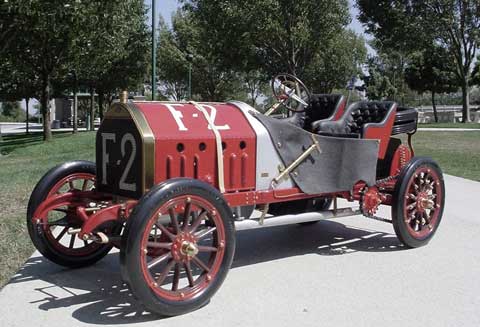 The famous 1907 Grand Prix Fiat which won the French Grand Prix. Fiats driven by Nazzaro also won the Targa Florio and the German Kaiserpreis races. This is not the real thing, however. Photo by Paul Koo (see notes below).
The famous 1907 Grand Prix Fiat which won the French Grand Prix. Fiats driven by Nazzaro also won the Targa Florio and the German Kaiserpreis races. This is not the real thing, however. Photo by Paul Koo (see notes below).
Two years later, Lancia’s Fiat beat Mercedes to win the Susa-Moncenisio hillclimb. In September of 1905, Alexandre Cagno’s 100 hp 16 liter Corsa Fiat climbed Mt. Ventoux in record time to win over Europe’s best. Nazzaro pulled off the hat trick in 1907 when he drove the Fiat F2 to capture the Targa Florio, the French Grand Prix and Germany’s Kaiserpreis, all in a single season. Both Vincenzo Lancia and Felice Nazzaro became makers of their own cars, but Nazzaro eventually returned to Fiat to head the competition department.
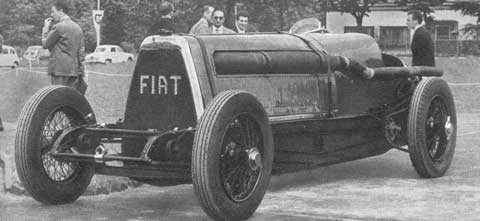
“Mephistopheles” in the 1950s at a British event. In 1924, it broke the Land Speed Record at 140.01. Courtesy Fiat.
Monsters in America
Having conquered the world of racing, record cars were next on the agenda. Nazzaro had taken the 18 liter “Mephistopheles” record car to Brooklands where, in 1908, he trounced Frank Newton’s supposedly invincible 90 hp Napier.
But as big, beastly and fast as the “Mephistopheles” was, it paled in comparison to a monster Fiat known as the S76. Set between the weak chassis members was one of the biggest four cylinder engines ever built, with 290 hp, 28,338 cc, originally intended for the Forlanini airship.
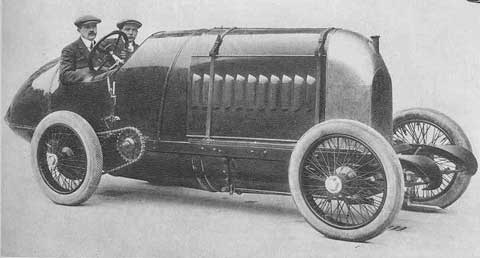
The S76 had a 7.5 inch bore and stroke of about 9.67 inches, making for a huge bonnet. It reportedly did 181.25 mph in 1912.
Courtesy Fiat.
Nazzaro had considered it “uncontrollable” through the streets of Turin, so Arthur Duray took it to Ostend, Belgium. There, in December of 1913, the fearsome Fiat recorded a one way run of 132.37 mph. In April, 1912, the S76 record car is said to have turned up in the United States, where, on a deserted stretch of the Vanderbilt Motor Parkway, it roared to an unofficial 181.25 mph mile.
Back in England, “Mephistopheles” found a new owner, Ernest Eldridge, who fitted it with a 6-cylinder 21,714 cc Fiat aircraft engine. April of 1924 found Eldridge at Montlhéry where his 146.01 mph two-way average earned Fiat the official international Land Speed Record. Malcolm Campbell’s 146.16 mph later nudged Eldridge out of the LSR title.
Vanderbilt Cup
Grand Prix winners, record-breakers—these were strong credentials for the new contender from Turin. Thus it was scarcely surprising that auto racers in America were quick to board the Fiat bandwagon. Fiat cars had been racing in the States since 1904 when Paul Sartori recorded a lap at the astonishing speed of 105 mph at New York’s Empire State track. Sartori and William Wallace also entered the first Vanderbilt Cup race in 1904, but without success.
In the second Vanderbilt Cup challenge, in 1905, Fiats put forth a stronger effort. For the race on the Long Island, New York road course, three 16.3-liter Fiats were entered for Nazzaro, for Louis Chevrolet (who crashed in practice and drove a customer’s car, which he wrecked in the race) and for Lancia. Sartori and Emanuel Cedrino drove 10,600 cc machines. After seven laps, big jolly Vincenzo Lancia was 21 minutes ahead of the second-place Panhard. Lancia had led from the start. With less than 65 miles to go, Lancia’s Fiat collided with Walter Christie’s car. Lancia lost 47 minutes in the pits while Christie was forced to retire. Hemery’s Darracq overtook Heath’s Panhard to win as a furious Lancia finished fourth.
The year 1905 also saw Swiss-born Louis Chevrolet, the eldest of the three Chevrolet brothers, score a victory for Fiat. In May Louis opened the new dirt track at Morris Park in the Bronx by winning the one-mile time trials and the three-mile “Free-For-All.” Then in 1906, Vincenzo Lancia returned to the Vanderbilt Cup wars and brought his Fiat home in second place.
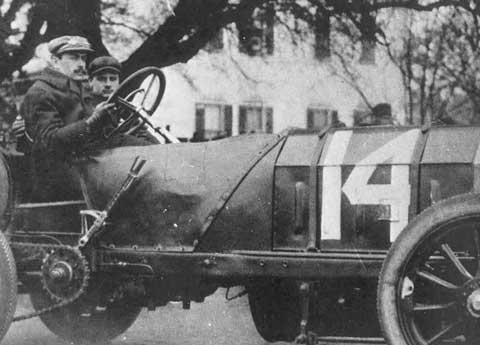
Wagner behind the wheel of the 1908 SB4, the 12 liter Fiat which won at the Targa Florio and the first American Grand Prize at Savannah.
Gentlemanly Ralph DePalma, who according to many experts was the best of all American race drivers, joined the Fiat factory team that captured the 1908 American Grand Prize. Run over a palm-lined 25-mile course on the outskirts of Savannah, this first of all U.S. Grands Prix was captured by Louis Wagner, whose Fiat averaged over 65 mph for 403 miles. Felice Nazzaro placed third and Ralph de Palma, who led the early laps, was ninth.
Notes:
The cars of Vincenzo Lancia are well known; less well known is the Nazzaro, built from 1911 to 1916 in Turin.
The color photo of the Fiat F2 was taken by Paul Koo, who built this 1/8 Pocher model. See his ebay store for more details. http://stores.ebay.com/POCHER-philes-FORUM
“Mephistopheles” was given the name by British fans who watched the great Napier-Fiat match race at Brooklands. Named after Faust’s devil, it is still running and makes occasional appearances at Goodwood.
Most of the great Fiat drivers escaped death on the tracks:
Louis Wagner, who was French, not German, died in 1960 at the age of 78 in Montlhéry, France.
Felice Nazzaro, a native of Turin, died in 1940 at the age of 59.
Ralph De Palma died at the age of 74 in 1956.
Louis Chevrolet, who raced at Indy four times, died at age 63 in 1941.
Vincenzo Lancia became a brilliant automaker and died of a heart attack in 1937 at the age
of 56.
One who did not was the American David Bruce-Brown, whose short but brilliant career driving Fiats will be related in Part 2.
Thank you Karl. Fiat was a hotbed of automotive talent and their senior engineering mentors at the beginning of the automotive century. We anxiously await your “Really Damned Fast was Expected” two volume set in the near future — and Part II of this outline.
this is the year of the happy birthday for fiat in your 110 th years old, i would like to say that fiat is for me the most important brand of the history in the automotive industries, your succes has been an inportant facts in the history racind car’s, for me is very important remember that days, the racing’s car’s has benn building for enjoyed our sense, that is more technical environment is passion, is feeling, is smile and cry, i’m a greatest lover of the racing car’s specially for a italian racing car’s. for haps, i say forza italia, forza fiat, forza maserati, forza alfa, forza lancia, forza bugatti, forza lamgorghini, forza isotta fraschini, forza itala, forza ceirano, forza diatto, forza abarth, forza ferrari, forza cisitalia, ok for finish: ¡forza il made in italy!
I am seking the location of Felice Nazaro’s grave.
I am the current owner of a 1913 tipo 55 60 hp 4 cylinder FIAT speed car ,(I love it ,also I have an original oil on canves of Ralph Wagner in the number 37 Fiat at Savannah painted in 1910 (AMERICAN GRAND PRIZE)also an original oil on canvis of the Beast of Turin painted before 1913 (on the reverse of the painting ,someone had written on the back (BY HIS STYLE YE SHALL KNOW HIM) ,I also have his solid silver model of the 1899 FIAT presented to him in 1900 by the fiat factory ,accompanied by a photo of his daughter in her Milan apartment taken with this silver fiat model.
I am blessed to have something that is wonderful as these items are.